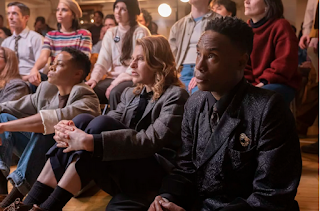I particularly loved seeing nurse Judy Kubrak (Sandra Bernhard) almost dragging a reluctant Pray Tell (Billy Porter) to his first meeting. Bernhard discusses ACT UP, and many other contemporary topics, in an expansive wonderful new interview for The Daily Beast.
The depiction of the group meeting was a bit simplistic, but served its purpose. It would be impossible to share the months of preparation that went into the Stop the Church protest, and the divisions within our ranks at the time over the action.
Other critiques and comments on the episode are included in a deft account by writer/editor Mathew Rodriguez for TheBody.com.
"Northrop did have some slight criticisms of the short depiction of the action in Pose -- mainly that it didn't capture just how big the demonstration really was. While there were hundreds of protesters inside, there were thousands outside protesting quite loudly. The protest included some of ACT UP's most well-known iconography, including artist and ACT UP member Ray Navarro dressed as Jesus and the poster of John Cardinal O'Connor next to an unrolled condom that said, "Know Your Scumbags."
Anachronisms aside (it took place on December 10, 1989, not
in 1990). The episode is set in winter, a few weeks or months later, so that's a small quibble. I saw it as a choreographic version of Pray Tell’s participation and empowerment.
 |
| ACT UP meeting in 'Pose' |
Of course the most 'scandalous' moment in the action (not included in the TV show), and covered by media as 'an outrage,' was that of former altar boy Tom Keane breaking a sacrament wafer at the altar.
The other shots in the Pose episode portrayed the screaming and arrests, which were not as lengthy inside as shown, except for the then-irascible Michael Petrelis, who instead of following the silent die-in theme, chose to stand atop a pew seat and repeatedly shout "Stop Killing Us!"
But these critiques are minor when one considers the gift of including this momentous event through an artistic lens in a hit TV show.
My own fictionalized account in my 2007 third novel, Cyclizen, included all that, but most specifically, being carried off on a stretcher by NYPD (in basic caps; the riot gear and helmets were worn by police outside, not as depicted in Pose). Like the show, my own depiction is personalized and literary, not documentary-style.
One overhead shot of Pray Tell being carried out with others on a stretcher echoed my own experience, a sort of epiphany, that what we were doing was not only right, but a Christian thing to do, like Jesus chasing the money-changers out of the temple.
The episode could have included a few shots of historic news footage of the thousands outside the cathedral, which ended up having a larger impact over time. ACT UP leader Maxine Wolfe says as much in a documentary about the action. But the Pose script took on a more personal version, that of Billy Porter's and others' characters finding a way to fight back.






